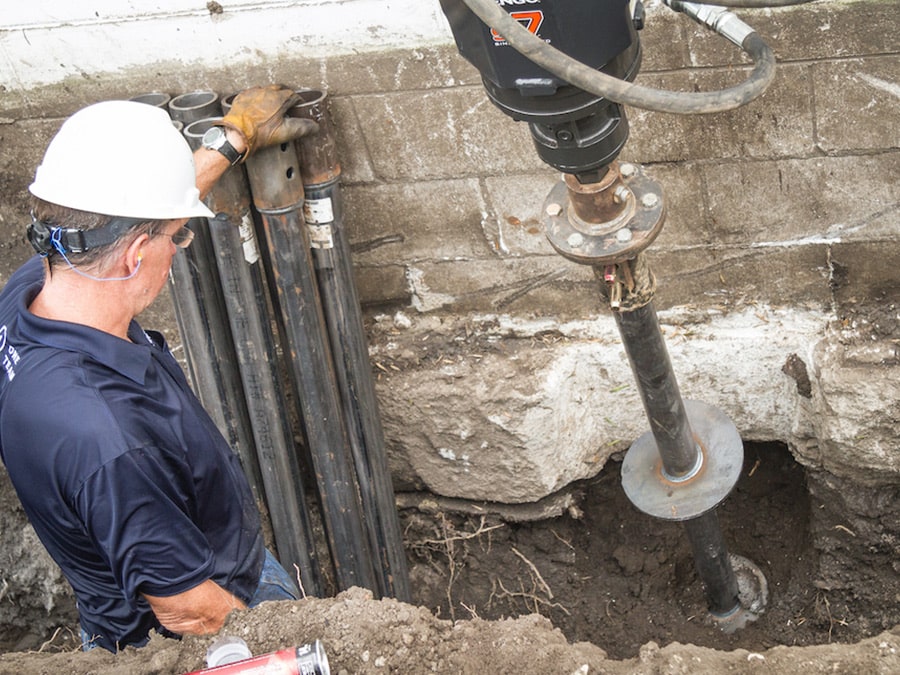Navigating Your Choices for Foundation Repair Oklahoma City: A Homeowner's Handbook
Navigating Your Choices for Foundation Repair Oklahoma City: A Homeowner's Handbook
Blog Article
Discovering Different Approaches of Structure Repair for Various Soil Types
Structure repair work is an essential aspect of maintaining structural integrity, particularly when thinking about the varied difficulties posed by various dirt types. The complexity of dirt behavior under differing conditions necessitates a tailored approach to fix, ensuring ideal options such as helical piers for unpredictable dirts or chemical cements for cohesive layers. Nevertheless, the concern remains: how do we establish one of the most efficient approach for each one-of-a-kind situation? Understanding the interaction in between soil attributes and fixing strategies is essential, yet there is even more to discover in the pursuit for sustainable options. What elements absolutely determine the selection of method?
Recognizing Dirt Types
Dirt types play a vital role in the security and longevity of structure structures, making it important for homeowners and construction professionals to recognize their attributes and actions. The communication in between soil and foundation can establish the architectural honesty of a structure. There are several dirt types, each with distinct physical residential properties that impact exactly how structures are designed and preserved.
Granular dirts, such as sand and gravel, offer excellent drain and are frequently considered steady. In comparison, cohesive dirts like clays and silts exhibit various habits.
Rocky soils, recognized for their toughness and security, deal exceptional support for foundations however may require customized tools for excavation. Alternatively, fertile dirts, which are a balanced blend of clay, sand, and silt, typically supply desirable problems for foundation support because of their modest drainage homes.

Comprehending these soil kinds is crucial for selecting proper foundation repair service methods, making sure the longevity and security of structures gradually.
Challenges With Extensive Clay
Among the various dirt types, expansive clay offers distinct difficulties for foundation stability as a result of its propensity to go through considerable quantity changes with wetness variant. This kind of soil swells when wet and contracts when completely dry, which can put in significant pressure on frameworks. These variations can bring about foundation cracking, heaving, and negotiation concerns, posturing significant threats to the architectural honesty of structures.
The difficulties with expansive clay are aggravated by its plasticity index, which measures the dirt's capability to alter shape and volume. A high plasticity index suggests greater possibility for movement, increasing the likelihood of damages to foundations. This is especially bothersome in regions experiencing extreme or regular weather condition modifications, where cycles of damp and completely dry conditions are common.
Moreover, the depth of extensive clay layers can differ, complicating the analysis and preparation of ideal foundation repair approaches. The uncertain nature of its activity requires specialized engineering options to reduce dangers. In addition, expansive clay can affect utility lines, driveways, and walkways, additionally complicating repair initiatives. These complexities require a detailed geotechnical analysis to make certain efficient foundation repair approaches are implemented, stressing the value of attending to extensive clay challenges with expertise and care.
Solutions for Sandy Soils
Sandy dirts, defined by their huge particle size and reduced cohesion, present distinctive challenges for foundation stability due to their propensity for moving and disintegration. By anchoring the foundation to much deeper, much more secure soil layers, these systems can provide the needed support to counteract the moving nature of sandy soils.
One more recommended method is the application of dirt stablizing approaches. Chemical grouting, for instance, involves injecting a stabilizing representative right into the soil, which boosts cohesion and minimizes leaks in the structure. This procedure aids to strengthen the sandy substratum, thereby reducing the risk of erosion and motion.
Furthermore, setting up appropriate water drainage systems is critical in sandy dirt problems. Ensuring sufficient water drainage can avoid water accumulation around the foundation, which frequently intensifies disintegration and soil displacement. Techniques such as French drains or surface grading can be employed to direct water away from the structure boundary.
Addressing Working Out in Loamy Soils
Loamy soils, known for their balanced mix of sand, silt, and clay, provide a productive base for several frameworks but can in some cases bring about foundation settling due to their special structure. This well balanced structure offers outstanding drainage and nutrient retention, making it excellent for agriculture and landscape design. However, this very same feature can end up being bothersome for foundations, as shifts in dampness material can trigger the soil to expand or agreement, causing working out.
Precise dirt screening is important to determine the particular make-up and dampness web content of the loam. As soon as data is collected, applying correct water drainage remedies is essential to keep consistent dampness degrees, consequently reducing the threat of soil contraction or growth.

Innovative Repair Strategies
In the realm of foundation repair, innovative strategies are continuously being developed to attend to the complex challenges postured by different dirt problems. foundation repair okc As soil kinds differ dramatically in their structural properties, standard methods might not always are sufficient. The advent of brand-new modern technologies in foundation repair service provides a lot more tailored services, guaranteeing security and longevity.
One noteworthy advancement is the use of helical piers, which are particularly efficient in unpredictable or expansive dirts (foundation repair oklahoma city). These piers are screwed right into the ground until they reach a steady layer of dirt, offering strong support for the foundation above. This technique lessens disturbance and is versatile to various dirt kinds, making it a versatile service
One more cutting-edge strategy is the application of polyurethane foam shot. This method entails infusing high-density polyurethane foam underneath the structure to load gaps and maintain the framework. It is a much less navigate to these guys invasive alternative to conventional base, using fast installment with minimal disturbance to the surrounding area.
Furthermore, dirt stabilization techniques, such as making use of chemical cements, have actually gotten grip. These compounds enhance soil stamina and decrease permeability, preventing future shifting. Jointly, these innovative repair techniques provide reliable remedies for the varied challenges posed by varying dirt problems.
Final Thought

Foundation repair service is a crucial element of keeping structural integrity, particularly when taking into consideration the diverse challenges presented by various dirt kinds (foundation repair oklahoma city). The intricacy of dirt habits under differing conditions requires a customized strategy to repair, making certain optimum remedies such as helical piers for unstable soils or chemical grouts for cohesive layers. By anchoring the foundation to much deeper, more stable soil layers, these systems can offer the needed support to combat the changing nature of sandy soils
Foundation repair service needs cautious factor to consider of soil types to make sure security and longevity. Chemical grouts improve soil stamina check these guys out and minimize leaks in the structure in cohesive dirts.
Report this page